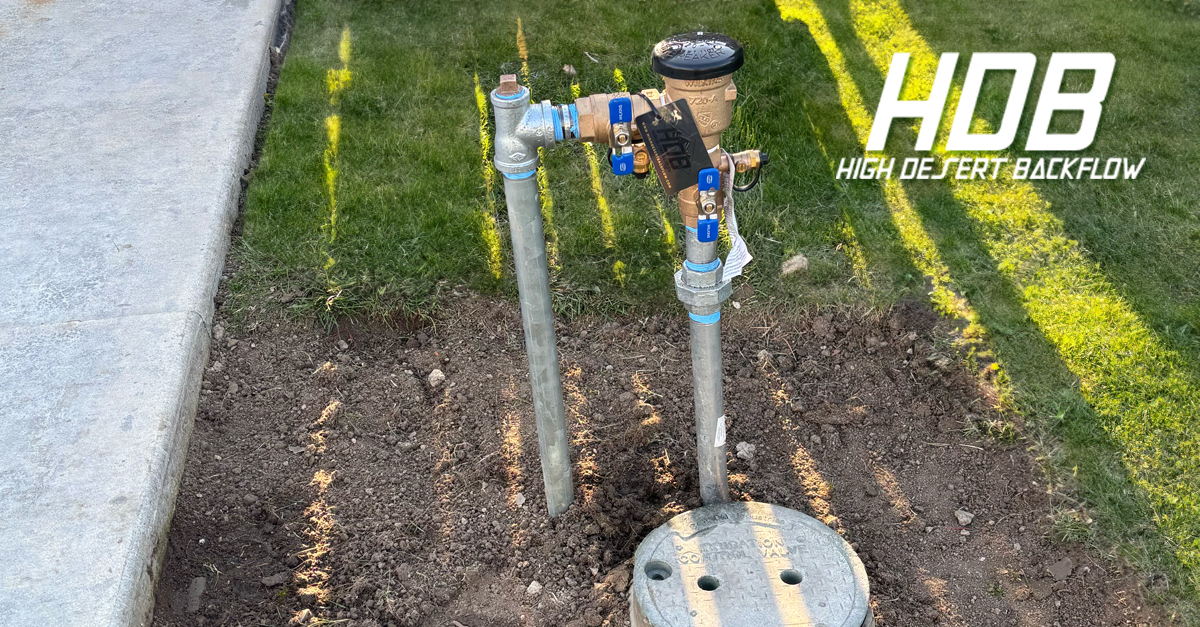Leaking or broken main and drain valves are common but that doesn’t mean they won’t lead to catastrophe if left untreated. A slow leaking valve will only get worse over time and eventually completely fail. In almost every case when a main valve fails property damage occurs, and quickly. But we can help.
Read on to learn what goes into a main and drain rehab; how to know if you need this project; and what you should look for in a vendor.
What’s a main and drain project?
A main line and drain replacement project typically involves upgrading, repairing or installing the main irrigation valves on a residential or commercial property. Here’s what’s generally included if you choose an experienced and reputable company like High Desert Backflow.
1. Site Assessment & Planning
- Inspect existing valves
- Locate underground utilities
- Permit and compliance with local regulations
- Determine trenching and excavation – soft digging
2. Main Line Work (Water Main)
- Replace main and drain valves
- Replace the main water line if pipe conditions warrant the work
- Pressure test for leaks
3. Excavate & Trench Work
- Dig trench for new or replacement valves
- Utilize soft digging when underground utilities pose a potential hazard
- Backfill and site restoration
4. Pipe Install & Connection
- Install new main and drain valves
- Connect pipe securely to municipal lines
- Ensure new valves and fittings are watertight
5. Cleanup & Restoration
- Backfill trenches with soil or gravel
- Restore sod when needed
- Replace concrete, asphalt or landscaping disturbed by excavation
- Final inspections and ensuring proper function
How do I know I need to initiate a main and drain project?
At High Desert Backflow, we’re expert at assessing what your issues are and how to quickly remedy them. Here’s what we watch for to determine if you’re a candidate for a main and drain project:
1. Water Supply Issues (Main Line Problems)
- Low water pressure to irrigation sprinkler heads
- Frequent leaks or bursts indicate aging pipes or shifting foundations that can cause cracks or breaks.
- Water bubbling up around meter box or current main and drain standpipes
- Water meter running constantly could indicate an underground leak in the main line or irrigation valves
2. Soft Spot in Landscape or Grass
- Pooling water could be a possible pipe crack, pinhole or total failure.
- Soft spot around the valves
- Water flowing from main valve standpipes
3. Renovation Needs
- Aging infrastructure of 15+ years old often requires preventative replacement to avoid costly emergency-based repairs.
- Replace old broken valves with new ¼ turn brass body valves
- If a double-check backflow assembly needs to be moved in the process of replacing old valves, a RPZ or PVB must be re-installed in its place to stay in compliance with Idaho state plumbing code.
What should I look for when I evaluate a company for a main and drain project?
When you’ve confirmed that you need to start a main and drain project, what’s next? Use this list to make sure that you hire a skilled laborer who checks all the boxes!
- Licensing & Certification. In Idaho, a valid license is required for residential and commercial work, so make sure to ask about it. If your project includes installing or repairing backflow prevention systems, you’ll want to make sure they have the proper backflow certification. And OSHA safety training is a priority for compliance and workplace safety.
- Experience & Specialization. A lot of laborers have experience with residential, but you’ll want someone with expertise in commercial water projects, too. They should have familiarity with the main water and irrigation lines and underground piping and a working knowledge of state plumbing and building codes and permit requirements.
- Reputation & References. This is a big one. Ask for references from past projects, check online reviews, testimonials or industry ratings and verify that they’ve performed similar work by reading through their portfolio or case studies.
- Equipment & Technology. Ask if they have access to heavy machinery if excavation is needed and that they’re trained to use hydro excavation.
- Insurance & Warranty. You’ll want to make sure your project includes general liability insurance to cover damages and workers’ compensation insurance to protect laborers. In addition, there should be a warranty on workmanship. For a water supply project, that warranty should be for one year.
- Cost & Contract Transparency. Get detailed estimates with labor, materials and timeline breakdowns, and ensure they provide a clear contract with a defined scope of work.
Success from Start to Finish
At High Desert Backflow, we’ll walk you through all the steps of your main and drain project to ensure you’re well informed and completely satisfied with all repairs upon completion.


